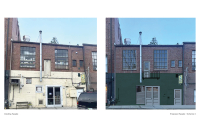Chaos erupting into beauty
 Stephanie Storey’s Oil and Marble, which was released this spring, is not only a page-turner but an eye-opener.
Stephanie Storey’s Oil and Marble, which was released this spring, is not only a page-turner but an eye-opener.
Taking place in Florence, Italy, in the years 1501 to 1505, it is the story of the artistic rivalry between two creative giants — Leonardo da Vinci and Michelangelo Buonarroti.
During a period of turmoil and warring factions in Italy, Leonardo and Michelangelo find themselves in Florence and working on commissions that will secure their places as legends in the annals of artistic history.
Leonardo is painting his portrait of the Mona Lisa. Michelangelo is working on his sculpture of David. Storey’s preamble sets the stage and takes us into the streets of Florence where we meet both artists and have a studio-side seat as they work tirelessly on their respective projects — blow by blow, brushstroke by brushstroke — and are then witness to the ardent competition between the two to become the toast of Florence and masters of the Italian Renaissance.
A youthful Michelangelo is a virtual unknown when he returns to Florence and wins the commission to carve what will become one of the most famous sculptures of all time. He lives impoverished at the foot of the misshapen block of marble, feverishly carving yet struggling to find the sculpture’s form and identity amidst impossible circumstances and an impossible deadline.
Meanwhile, the elder Leonardo’s life is falling apart: he loses the hoped-for David commission, he can’t seem to finish any project, he is obsessed with the creation of a flying machine, he almost dies in war, his engineering designs fail disastrously, and he is haunted by a woman he has seen in the market — a merchant’s wife, whom he is finally commissioned to paint. Her name is Lisa, and she will become his muse.
Related Items
Storey gives us so much detail that we feel we are in the cramped unventilated space Michelangelo has built as an ad-hoc studio as he hammers away at the large block of white Carrara marble while constantly inhaling the swirling stonedust. Likewise, we sit beside Leonardo as he struggles, stroke by stroke, to paint his unique masterpiece.
“Sketch, burn, sketch, burn. Day after day, week after week he fought with his sketchpad, the chalk, the stone, himself, and all under the scrutiny of the public. All around him, carpenters and stonecutters tended to the cathedral’s constant repairs. Every day the men hung new tiles, replaced crumbling marble, and cleaned the exterior, struggling to keep up with the perpetual wear and tear. Michelangelo enjoyed the hum of the workshop, but he regretted not asking the city for a private space. Florentines camped out with loaves of hard rye bread and fiaschi of Chianti to watch him toil and to take bets on whether he would finish. The locals called the stone ‘Il Gigante,’ not only because of its enormous physical dimensions, but also for its outsized problems.”
Meanwhile, across town Leonardo sits in the studio of his posh residence and contemplates the small canvas sitting on his work easel.
“He had already rendered her facial features precisely: the shape of her eyes, the turn of her cheek, the silky curve of her lips. Usually, such a realistic representation of a subject would have satisfied him, but this time, he yearned to go further. He didn’t want to only capture the lady’s physical features or the glint in her eye or even her energy in a gesture or movement. No, he wanted to know the lady, as fully as anyone, and communicate her whole person to the world. He wanted to capture her soul … There in front of Lisa’s portrait he stared at her expression, but still could not feel her there. Over the next two hours, he added three more tiny brushstrokes to the dark silk of her gown.”
And so the story goes, chip by chip, brushstroke by brushstroke, until the unveiling of Michelangelo’s David and of Leonardo’s Mona Lisa. In the end this book is as much a love story as it is an historical narrative of time and place. Leonardo’s love for the muse Lisa and Michelangelo’s loving obsession to create something of great beauty from a block of imperfect stone. Stephanie Storey perfectly describes this artistic love as she paints her own masterpiece in the character of Leonardo.
“As with love itself, when a person pulled back to study it, the very thing they were trying to understand was destroyed. Because love doesn’t thrive under scrutiny from a distance, but flourishes from closeness and unquestioning faith. It blooms in the deep parts of the heart, in the silence where no thought is allowed. The only way to be truly in love is to be fully in it, just as the only way to feel the secret of the Mona Lisa was to give the heart absolutely to it.”
And then she chisels this passage with the words of Michelangelo amidst an intense conversation between the two artists.
We are like lovers, aren’t we, we artists?” Michelangelo dragged his fingers across the rough stone. “Timid at first, skeptical about what we might find beneath the surface, but the more time we spend with the objects of our desire, the more we start to understand them. We find their flaws but also their possibilities. And when we connect, our hearts beat in time, and when we speak, our voices come from one mouth. Through love, we dialogue with our own souls.” Michelangelo opened his eyes and stared into the gray stone. “Love defies planning, doesn’t it? There is no reason and no answer and no rhyme that can recreate it. But in an instant we feel it, a tingle on top of our heads, down our necks, into our fingertips. And we don’t know why or how it’s there, but it is, existing because of us, in spite of us. We don’t know what it is. We don’t know, and in the very act of not knowing, we feel everything.”
As Elizabeth Cobbs, author of the historical novel The Hamilton Affair, writes on the back jacket of the book: “With every chip of the chisel and stroke of the brush, Stephanie Storey fashions a mesmerizing tale of the envy, ambition, and artistic genius that drove an epic rivalry. Oil and Marble will make readers long for Florence and to see David in the morning light.” All this reader/reviewer has to say in addition is: Amen to that! and look for this novel to be made into a major motion picture very soon. Or as Storey writes from the perspective of her two main characters in a would-be final exchange, deftly putting masterly touches on her own masterpiece: “Emotion without intellect is chaos,” Leonardo sneered. Staring into Leonardo’s golden-colored eyes, Michelangelo countered, “Chaos erupting into beauty. That’s art.”
Thomas Crowe is a frequent book reviewer for The Smoky Mountain News. His most recent publication is an historical novel set in the Shaker community of Pleasant Hill, Kentucky, in the 1840s entitled The Watcher (Like Sweet Bells Jangled). His books are available at City Lights Bookstore in Sylva and the Jackson County Library. He can be reached at This email address is being protected from spambots. You need JavaScript enabled to view it.









